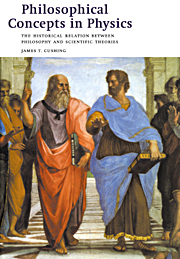 Philosophical Concepts in Physics
Philosophical Concepts in Physics Published online by Cambridge University Press: 05 June 2012
The beauty and clearness of the dynamical theory, which asserts heat and light to be modes of motion, is at present obscured by two clouds. I. The first came into existence with the undulatory theory of light, and was dealt with by Fresnel and Dr. Thomas Young; it involved the question, How could the earth move through an elastic solid, such as essentially is the luminiferous ether? II. The second is the Maxwell–Boltzmann doctrine regarding the partition of energy.
Lord Kelvin (William Thomson), Nineteenth Century Clouds Over the Dynamical Theory of Heat and LightNewton, forgive me; you found the only way which, in your age, was just about possible for a man of highest thought- and creative power. The concepts, which you created, are even today still guiding our thinking in physics, although we now know that they will have to be replaced by others farther removed from the sphere of immediate experience, if we aim at a profounder understanding of relationships.
Albert Einstein, Autobiographical NotesTo save this book to your Kindle, first ensure [email protected] is added to your Approved Personal Document E-mail List under your Personal Document Settings on the Manage Your Content and Devices page of your Amazon account. Then enter the ‘name’ part of your Kindle email address below. Find out more about saving to your Kindle.
Note you can select to save to either the @free.kindle.com or @kindle.com variations. ‘@free.kindle.com’ emails are free but can only be saved to your device when it is connected to wi-fi. ‘@kindle.com’ emails can be delivered even when you are not connected to wi-fi, but note that service fees apply.
Find out more about the Kindle Personal Document Service.
To save content items to your account, please confirm that you agree to abide by our usage policies. If this is the first time you use this feature, you will be asked to authorise Cambridge Core to connect with your account. Find out more about saving content to Dropbox.
To save content items to your account, please confirm that you agree to abide by our usage policies. If this is the first time you use this feature, you will be asked to authorise Cambridge Core to connect with your account. Find out more about saving content to Google Drive.